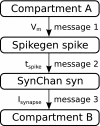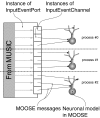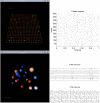Run-time interoperability between neuronal network simulators based on the MUSIC framework
- PMID: 20195795
- PMCID: PMC2846392
- DOI: 10.1007/s12021-010-9064-z
Run-time interoperability between neuronal network simulators based on the MUSIC framework
Abstract
MUSIC is a standard API allowing large scale neuron simulators to exchange data within a parallel computer during runtime. A pilot implementation of this API has been released as open source. We provide experiences from the implementation of MUSIC interfaces for two neuronal network simulators of different kinds, NEST and MOOSE. A multi-simulation of a cortico-striatal network model involving both simulators is performed, demonstrating how MUSIC can promote inter-operability between models written for different simulators and how these can be re-used to build a larger model system. Benchmarks show that the MUSIC pilot implementation provides efficient data transfer in a cluster computer with good scaling. We conclude that MUSIC fulfills the design goal that it should be simple to adapt existing simulators to use MUSIC. In addition, since the MUSIC API enforces independence of the applications, the multi-simulation could be built from pluggable component modules without adaptation of the components to each other in terms of simulation time-step or topology of connections between the modules.
Figures













Similar articles
-
NeuroML: a language for describing data driven models of neurons and networks with a high degree of biological detail.PLoS Comput Biol. 2010 Jun 17;6(6):e1000815. doi: 10.1371/journal.pcbi.1000815. PLoS Comput Biol. 2010. PMID: 20585541 Free PMC article.
-
A configurable simulation environment for the efficient simulation of large-scale spiking neural networks on graphics processors.Neural Netw. 2009 Jul-Aug;22(5-6):791-800. doi: 10.1016/j.neunet.2009.06.028. Epub 2009 Jul 2. Neural Netw. 2009. PMID: 19615853
-
iSpike: a spiking neural interface for the iCub robot.Bioinspir Biomim. 2012 Jun;7(2):025008. doi: 10.1088/1748-3182/7/2/025008. Epub 2012 May 22. Bioinspir Biomim. 2012. PMID: 22617339
-
Model structure analysis in NEURON : toward interoperability among neural simulators.Methods Mol Biol. 2007;401:91-102. doi: 10.1007/978-1-59745-520-6_6. Methods Mol Biol. 2007. PMID: 18368362 Free PMC article. Review.
-
Effects of local connectivity on striatal function: stimulation and analysis of a model.Synapse. 1995 Aug;20(4):281-98. doi: 10.1002/syn.890200402. Synapse. 1995. PMID: 7482288 Review.
Cited by
-
Integration of biochemical and electrical signaling-multiscale model of the medium spiny neuron of the striatum.PLoS One. 2013 Jul 3;8(7):e66811. doi: 10.1371/journal.pone.0066811. Print 2013. PLoS One. 2013. PMID: 23843966 Free PMC article.
-
Investigation of Cannabis sativa Phytochemicals as Anti-Alzheimer's Agents: An In Silico Study.Plants (Basel). 2023 Jan 22;12(3):510. doi: 10.3390/plants12030510. Plants (Basel). 2023. PMID: 36771595 Free PMC article.
-
Deploying and Optimizing Embodied Simulations of Large-Scale Spiking Neural Networks on HPC Infrastructure.Front Neuroinform. 2022 May 19;16:884180. doi: 10.3389/fninf.2022.884180. eCollection 2022. Front Neuroinform. 2022. PMID: 35662903 Free PMC article.
-
Exploring the role of striatal D1 and D2 medium spiny neurons in action selection using a virtual robotic framework.Eur J Neurosci. 2019 Mar;49(6):737-753. doi: 10.1111/ejn.14021. Epub 2018 Aug 1. Eur J Neurosci. 2019. PMID: 29917291 Free PMC article.
-
Event-Based Update of Synapses in Voltage-Based Learning Rules.Front Neuroinform. 2021 Jun 10;15:609147. doi: 10.3389/fninf.2021.609147. eCollection 2021. Front Neuroinform. 2021. PMID: 34177505 Free PMC article.
References
-
- Bower JM, Beeman D. The book of GENESIS: Exploring realistic neural models with the GEneral NEural SImulation System. 2. New York: Springer; 1998.
-
- Carnevale NT, Hines ML. The NEURON Book. U.K.: Cambridge University Press; 2006.
Publication types
MeSH terms
LinkOut - more resources
Full Text Sources
Other Literature Sources

